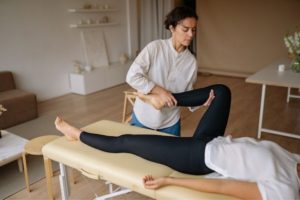If you have ever experienced sharp pain in your calves after doing calf raises, don’t fret.
Many people have been unable to walk properly after this seemingly harmless exercise. But why does this happen?

Below, I’ll explore the possible reasons behind the pain and discomfort after doing calf raises and provide helpful tips, so let’s dive right in.
I Can’t Walk After Doing Calf Raises – Why?
Many sport-oriented individuals like calf raises, as they help strengthen the calf muscles and make jumping, running, and walking easier.
However, most people who perform this exercise experience pain and difficulty walking after doing calf raises, especially new fitness enthusiasts.
Here’s a list of possible reasons for experiencing pain and prevention tips.
Microscopic Muscle Tears
When doing calf raises, the gastrocnemius and soleus muscles contract and lengthen repeatedly. This can cause microscopic tears and damage to the muscle tissue.
Although this damage helps muscles grow and develop, it can also cause sharp pain and discomfort.
Improper Form or Technique
Most beginners perform calf raises improperly and experience pain and discomfort as a result.
For instance, if you lock out your knees or stand with your feet too close together, you’re guaranteed pain and difficulty walking after doing calf raises.
These mistakes can place unnecessary strain on your muscles and joints, which results in pain.
Overtraining
Doing too many calf raises or overtraining can result in pain. Like all muscles, your calf muscles need time to rest and heal between workouts.
If you don’t allow your muscles to recover, you can experience muscle fatigue and even injury.
Muscle Imbalance
A muscle imbalance between your gastrocnemius and soleus muscles can cause pain after doing calf raises.
Sometimes, one muscle is stronger than the other, causing a very irregular distribution of force and resulting in pain and discomfort.
Why Do Calf Raises Hurt So Much?
Calf raises can hurt for multiple reasons. First, calf raises target mainly the calf muscles, usually smaller than other leg muscles, such as hamstrings or quadriceps.
Therefore, calf muscles can be harder and more intense for those muscles, resulting in more significant discomfort, soreness, and pain.
Additionally, calf raises require the calf muscles to do a very eccentric contraction when the muscle lengthens as it contracts.
Eccentric contractions can result in more muscle soreness and damage than concentric contractions when the muscle shortens as it contracts.
Moreover, calf raises can hurt because some people don’t stretch and warm up the calf muscles properly before starting the exercise.
If you don’t stretch and warm up your tight and stiff muscles before exercising, you can experience more pain and even injure yourself.

Finally, if you’re a newbie or haven’t done calf raises for some time, you can experience more pain, soreness, and discomfort.
So, don’t worry, as your muscles will adapt over time and become stronger. Start small and gradually increase the intensity and frequency of your calf raises over time.
4 Tips for Doing Calf Raises without Hurting Yourself
Here’s a list of tips for doing calf raises without injuring yourself:
1. Start Small
I suggest starting with a lower weight or resistance and increasing the intensity over time, especially if you’re a beginner or haven’t done calf raises in a while.
Starting small helps muscles adapt and grow stronger without causing much pain or damage.
2. Perform Calf Raises Properly
As mentioned, proper form and techniques matter when doing calf raises because they help prevent pain and difficulty walking.
So, keep your knees slightly bent, your feet shoulder-width apart, and your movements slow and controlled.
3. Let Your Muscles Rest and Recover
You should let your muscles rest and recover between calf raises.
For instance, take a day or two off between workouts and include exercises that strengthen and grow other muscle groups.
4. Try Stretching and Foam Rolling after Workouts
After workouts, you can decrease muscle soreness and tightness with stretching and foam rolling.
These things can help improve circulation and promote muscle recovery.
Overall, calf raises can result in pain and discomfort for many reasons.
However, you can reduce soreness, pain, and even serious injuries by performing calf raises properly, gradually increasing the intensity or weight, and letting your muscles rest and recover.
Lastly, you should never push yourself beyond your limits. Accept the fact that you can’t strengthen your calf muscles overnight.
However, you can get strong and toned calves with time and dedication without experiencing too much pain.
Can Calf Raises Cause Injury?
Calf raises can benefit your calf muscles, although they’re low-impact exercises. But, like any exercise, they can also cause injuries if done incorrectly or excessively.
Common injuries caused by calf raises include Achilles tendonitis, muscle strains, and plantar fasciitis.
How Long Does It Take to Recover from Calf Raises?
How long it takes to heal from calf raises depends on your fitness level and the intensity of your workout.
However, most people will experience mild pain or soreness in the calf muscles for 24-48 hours after a workout.
Experiencing some pain and soreness isn’t uncommon. On the contrary, it’s a normal part of recovery.
However, if you notice swelling or bruising or experience severe pain, rest more and let your muscles recover properly for a few days.

How to Speed up the Recovery?
You can speed up the recovery process after calf raises in various ways. For starters, you can rest for a few days and let your muscles heal.
Avoid strenuous activities and exercise that can worsen the injury.
You can also apply ice or heat to the affected area to reduce swelling and speed up the healing.
Heat can boost circulation and relax muscles. On the other hand, ice can help reduce inflammation.
Some fitness enthusiasts also suggest stretching and foam rolling after exercise.
Stretching your calf muscles can help boost flexibility and reduce the risk of injury, while foam rolling can help reduce muscle soreness and break up scar tissue.
Finally, you can speed up recovery by massaging the affected area.
A good massage can help break up scar tissue, improve circulation, decrease muscle soreness, and promote healing.
Should I Walk with Calf Pain?
Whether or not you should walk with calf pain depends on the severity of your pain and discomfort.
If you’re experiencing mild symptoms, walking can help improve circulation and promote healing.
However, if you can’t stand the pain and notice bruising or swelling, you must rest and avoid walking or doing anything that can further strain your muscles.
Seek medical attention if your calf pain doesn’t go away or worsens.
Healthcare experts can determine the severity of your injury and provide the necessary treatment.
Final Thoughts
In a nutshell, calf raises cause pain and discomfort for several reasons.
However, if you experience mild pain, don’t freak out immediately, as it’s a normal part of recovery.
Visit healthcare professionals if your pain increases or you notice swelling or bruising.
They can help assess the severity of your injury, provide various treatments, and share helpful advice.
Overall, by stretching before doing calf raises, performing the exercise properly, and not pushing your limits, you will strengthen your calves without hurting yourself.

When I was in high school, I was the best at running. Running for me is not a trend, this is my whole life. I jog every morning, without exceptions: I don’t skip mornings on vacations or business trips. My friends are also sports fans: I went to my best friend’s yoga class for the first time about three years ago.
Since then, I’ve been practicing regularly, and we have also made several yoga trips to India. For my last birthday, I got a skateboard as a present from her. Now we’re both taking personal classes with a coach, and it’s 100% fun!





